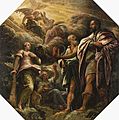Morality facts for kids
Morality is all about understanding what is right and wrong. It's like having a set of rules or a compass that guides your actions and choices. These guidelines help us decide how to act towards others and in different situations.
Many people have thought deeply about how we figure out what the "right" thing is. Some believe that there's a universal morality, meaning certain things are always right or wrong, no matter what anyone thinks. They might believe these rules come from a higher power, like God. Others think that morality is more personal or depends on the group you're in. This means what's considered good or bad can change from one community to another.
People learn about morals from many places. Your parents, friends, and school often teach you about good behavior. Religion and books can also share important lessons. Sometimes, you learn from ethical traditions, which are ways of thinking about right and wrong that have been passed down through generations. People who teach or strongly follow these moral ideas are sometimes called moralists.
Morality can also be a lesson you learn from a story. Often, a fable or tale will end with a clear message, like "The moral of this story is..." This tells you the main lesson the story wants to teach.
The opposite of "moral" is "immoral." This means doing something that is definitely wrong. On the other hand, "amoral" describes something that isn't about right or wrong at all. It's like saying something is "morally neutral," meaning it has no good or bad side to it. Being able to tell the difference between right and wrong is a big part of understanding morality.
Contents
Understanding Right and Wrong
Figuring out what is right and wrong can sometimes be tricky. It often involves thinking about how your actions affect other people and the world around you.
Where Do We Learn Morals?
We pick up our moral ideas from many different sources as we grow up.
- Family and Friends: Your parents, guardians, and friends often teach you what they believe is right and wrong through their words and actions.
- School: Teachers and school rules help you learn about fairness, respect, and responsibility.
- Stories and Books: Many stories, from fairy tales to novels, have hidden or obvious moral lessons.
- Religion: For many people, their religious beliefs provide a strong guide for moral behavior.
- Society: The general rules and expectations of the community you live in also shape your understanding of morality.
Moral Lessons in Stories
Have you ever read a story and at the end it says, "The moral of the story is..."? This is a common way to share a lesson about life or behavior. Fables, which are short stories often with animals as characters, are famous for having clear morals. For example, "The Tortoise and the Hare" teaches that "slow and steady wins the race."
Moral, Immoral, and Amoral
It's helpful to know the difference between these words:
- Moral: This means something is considered good, right, or acceptable.
- Immoral: This means something is considered bad, wrong, or unacceptable. It goes against what is generally thought of as good behavior.
- Amoral: This is different from immoral. It means something doesn't have anything to do with right or wrong. For example, a rock is amoral; it can't choose to be good or bad. A very young baby might also be considered amoral because they don't yet understand moral rules.
Related pages
Images for kids
-
Allegory with a portrait of a Venetian senator (Allegory of the morality of earthly things), attributed to Tintoretto, 1585
-
Immanuel Kant introduced the categorical imperative: "Act only according to that maxim whereby you can, at the same time, will that it should become a universal law."
See also
 In Spanish: Moral para niños
In Spanish: Moral para niños



